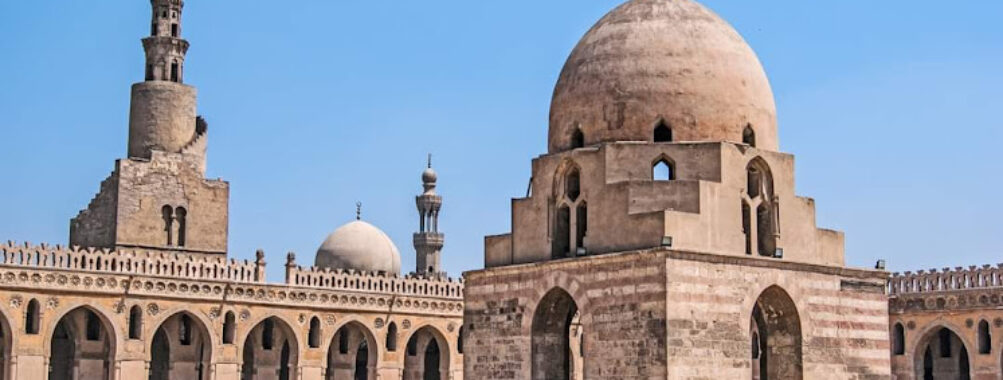
Ibn Tulun Mosque
“`html
Table of Contents
Description
The Mosque of Ibn Tulun is one of those places that quietly takes your breath away before you even realize it. Built in the late 9th century by Ahmad ibn Tulun, the then-governor of Egypt, it stands today as the oldest surviving mosque in Cairo that has remained largely in its original form. That alone makes it worth the trip, but it’s not just about age—it’s about atmosphere. The mosque sprawls across an expansive courtyard, ringed by arcades with stucco decorations that feel both ancient and timeless. And then there’s the minaret, famous for its spiral staircase that winds up the outside—an unusual feature in Egypt but inspired by the mosques of Samarra in Iraq.
Walking through the mosque, you’ll notice how different it feels compared to the more ornate mosques you may see later in Cairo. It’s simple, almost austere, yet the scale is massive. The open courtyard, the play of light and shadow under the arches, and the whisper of history in every corner—it all creates a sense of calm that’s hard to put into words. Some visitors rave about the peacefulness, others come away underwhelmed if they expected glittering mosaics and domes. But that’s the beauty of it: Ibn Tulun Mosque isn’t about dazzling you with decoration, it’s about giving you space to breathe and reflect in a city that rarely slows down.
Key Features
- A striking spiral minaret with an external staircase, one of the few of its kind in Egypt
- Expansive central courtyard surrounded by arcades with carved stucco details
- Original 9th-century architecture, making it the oldest mosque in Cairo that still stands intact
- Historic location believed by some traditions to be on the hill where Noah’s Ark once rested
- A sense of tranquility and openness rare in central Cairo
- Basic amenities available, including restrooms for visitors
Best Time to Visit
Cairo can be hot—scorching, actually—so timing your visit makes a big difference. Early mornings are my personal favorite; you’ll catch the soft light pouring into the courtyard, and you might even have the whole place nearly to yourself. Late afternoons are also lovely, with golden light hitting the arches and minaret just right. Avoid midday in summer unless you enjoy feeling like you’re walking across a frying pan. Winter months, from November to February, are generally the most comfortable for exploring, though honestly, the mosque is worth seeing in any season if you pace yourself and bring water. Fridays can be busier due to prayers, so if you’re looking for quiet exploration, aim for another day of the week.
How to Get There
Reaching the mosque isn’t complicated, but Cairo traffic can make even the shortest trip feel like an odyssey. If you’re staying in central Cairo, a taxi or ride-hailing app is the most straightforward option. Just be sure to have the name of the mosque written down in Arabic, as not every driver will recognize the English name. For the more adventurous, you can pair a visit here with a walk through the historic Sayeda Zeinab district, which is full of local life—markets, food stalls, and the kind of street scenes that stick in your memory long after you’ve left. Public transport is possible but not always comfortable for first-time visitors, so most travelers opt for private cars or guided tours that include the mosque as part of a larger itinerary.
Tips for Visiting
A few practical things can make your visit smoother. First, dress modestly—it’s an active place of worship, and covering shoulders and knees is a sign of respect. Women may want to bring a scarf for their heads, though sometimes coverings are provided at the entrance. Second, wear shoes that are easy to slip on and off, since you’ll need to remove them before entering the prayer areas. I once made the mistake of wearing lace-up boots here… not recommended when you’re juggling them in your hands and trying to take photos at the same time.
Bring a bottle of water, especially if you’re visiting during warmer months, because the courtyard is exposed and the sun can be relentless. Photography is generally allowed, and the play of light under the arches makes for some stunning shots, but always be mindful of worshippers. If you’re a history buff, it’s worth reading a little about the Abbasid influence on Cairo before you go—it’ll help you appreciate why this mosque looks so different from the Mamluk and Ottoman mosques you’ll see elsewhere in the city. And finally, don’t rush. The magic of Ibn Tulun isn’t in checking it off a list, it’s in standing still, letting the silence sink in, and realizing you’re standing in a space that has watched over Cairo for more than a thousand years.
“`
Location
Places to Stay Near Ibn Tulun Mosque
Find and Book a Tour
Explore More Travel Guides
No reviews found! Be the first to review!